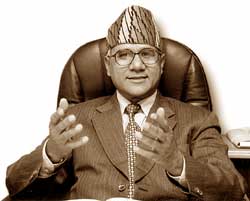BC Sharma is the CEO of the Nepal Life Insurance Company (NLIC) and a veteran in the insurance business. After working at the Life Insurance Company of India for more than 30 years, he has returned to Nepal to start his private sector company. He spoke to Nepali Times and said the number one challenge is to change the peoples' mindset about insurance. Excerpts:
 How would you assess the present life insurance market in Nepal?
How would you assess the present life insurance market in Nepal?
Life insurance depends on two basic factors-the purchasing capacity of people and penetration of the insurers' message. About 40 percent of the population in Nepal lives below poverty and nearly 16 percent is above 60 years of age, making those segments technically uninsurable. That leaves us with 44 percent of the population. Of this, 17-18 percent are children below 6-7 years of age. This narrows our demographic to 20-25 percent of the population. The five life insurance companies cover only 1.5-1.7 percent of the total population in the country.
That is a very narrow base, are you trying to diversify the services you offer?
We have an endowment policy that provides risk coverage for people between 15 and 50 years of age. Our second product is a money-back scheme called "Dhana Barsha". Two terms, one for 15 years and another for 20, are available but the policy age limit for entry and exit are the same. We recently launched two types of polices for children that insures the father as well.
How have you fared so far?
Nepal Life Insurance Company is a new entrant. The promoters are renowned business people and our workforce is primarily local. We've done well from the outset, especially after issuing company shares last August. The entire process for listing our shares on the Nepal Stock Exchange has been completed. Rastriya Beema Sansthan (RBS) is the market leader in life insurance, but among the three new entrants-ALICO, LIC and NLIC-we are in the lead with a market share of 18-20 percent. To date, we have issued 16,500 policies and the premium collection is also on the higher side. Our average per policy premium collection is Rs 6,000, which is good in comparison to other SAARC countries.
How has the conflict impacted business?
I cannot speak for others, but it had no effect on us. We have received 13 death claims so far from which only two appeared to be insurgency related. The rest were natural deaths. Of course, people in the worst Maoist insurgency affected areas did not have access to life insurance services.
All around the world life insurance acts as social security. If a certain individual is insured with us, the insured amount will go to the family. If the breadwinner mortgages the house and dies, the insurance mortgage policy can pay off the loan so the family continues to have a roof over their heads. If HMG desires, national life insurance companies can develop products that are within the reach of all sections of Nepali society.
What role does the Beema Samiti play in the market?
The Beema Samiti (Insurance Board) and the operators work together. Specifically, the consumer education must come from them, increasing the market for everyone. The insurers, on their part, must take advantage of consumer education. It is their responsibility to create new products tailored to the needs of their consumers.
To be honest, I have reservations about the government's tax policies. If you treat life insurance as a social security net, then you have no right to tax the bereaved after the claim is settled. There are certain types of expense that are not tax deductible from income. Secondly, all over the world life insurance companies are taxed after the actuarial valuation and we should follow set standards here in Nepal.
Are you aware of Indian life insurers operating illegally in the tarai?
In fact, we have given this in writing to the Beema Samiti and the Department of Inland Revenue. We estimate approximately Rs 3 billion may have been siphoned off from the tarai in the last five years. Most people get duped with these policies. We are already focusing on these areas. About 60 percent of our policies are sold in the tarai.
What challenges do you see for the insurance business in Nepal?
The number one challenge is changing the mindset of the people. That can happen only through consumer education. The other thing that must be redressed is agents taking licenses from many life insurers. This makes him less committed to any company, and the feeling of ownership is missing.
At the directive of the regulator, an investment committee is constituted comprising all five life insurers. We have to invest 75 percent of the surplus fund in government bonds or designated banks, 10 percent in finance companies and 15 percent towards company development to maintain liquidity. Since bank interest rates are dropping, we want to invest in long-term projects, say related to infrastructure development. We have already conveyed this to the government. I think the life insurance companies operating today can now pull in Rs 2 billion for long-term investment.


